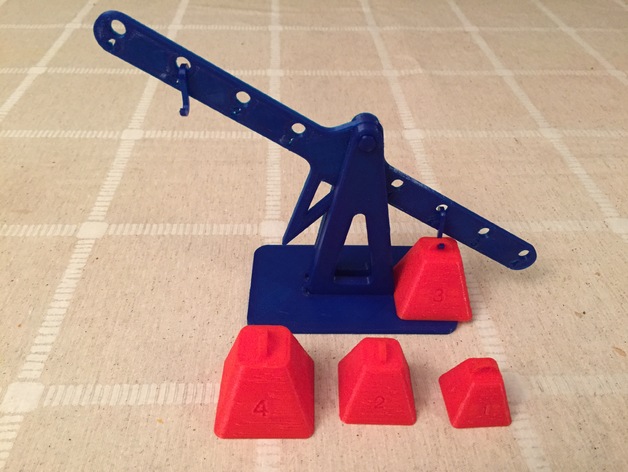
Lever principle and Equilibrium
thingiverse
This is my entry for the MakerEd Project Challenge. I am currently studying to became a vocational training teacher and I thought this challenge could help me thinking about simpler ways to explain enginnering concepts to my future students. In this case I've created a model to explain how levers work and how you can reach the balance applying an opposite torque but taking into account weights and distances. It is quite a simple concept for those who are used to it but not so if we are talking about young students. With this project I want to help students understanding those concepts of torque (distance x weight), lever and equilibrium. Discovery learning can be used to learn those concepts! Print Settings Printer: BCN3D+ Rafts: No Supports: No Resolution: 0.2 Infill: 20% is ok Notes: All parts can be printed without supports How I Designed This I designed this project trying to keep parts as simple as possible. This project could be used as it is for future teaching or can be given as an example to students so they can design and build their own models. If they can be 3D printed that's great, but if not they can be build using other techniques and materials (cardboard, paper, wood....) Lever principle Project: Lever principle and equilibrium Objectives Students will learn the concepts of torque, lever and equilibrium. Those are very important concepts and very common ones when studying mechanical subjects. Also this will be a great opportunity for students to learn how to desing and 3D print simple parts that will be assembled in a more complex assembly. Audiences This project is appropriate for students aged 12 to 16 and for those who are studying first course of any vocational training degree related to mechanics. Preparation It would be necessary for students to know some basics in 3D designing and printing. The school should also have a 3D printer in order to print student's models. If this is not the case, the teacher can give students the model shown in this project and they can learn the concepts of torque and lever experimenting with it. Steps! First of all students have to think about the concept of torque and lever. The teacher will ask them to design a model where those concepts could be applied. Student will design their models using any 3D designing software available. They will take into account 3D printing limitations when designing their models. Students will print their designs. "Playing" with them they will learn what a torque is and how levers work. They can show to other students their creations and explain to them how they work. This project can be the first step to other similar projects where other theoretical concepts can be explained using models. Results Students will learn how to design and manufacture (3D printed if possible) a model that can help them understand the concepts of torque, lever and equilibrium. This will help them developing their creativity and introduce them in the 3D printing world. Relating concepts with phisical objects is also an interesting way of learning, making the learning process stronger.
With this file you will be able to print Lever principle and Equilibrium with your 3D printer. Click on the button and save the file on your computer to work, edit or customize your design. You can also find more 3D designs for printers on Lever principle and Equilibrium.
